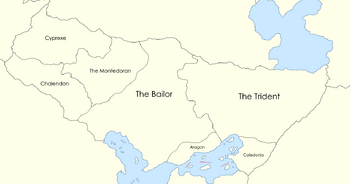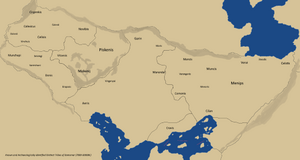Seven United
The Unified Damsmarian States of The Seven United | |
|---|---|
|
Flag | |
Motto: United in Difference | |
 Damsmar with the Seven States of the Seven United overlayed | |
| Capital | Aygon |
| Largest city | Aygon (4,428,500) |
| Official languages | English, French, Spanish, Pizko |
| Recognised national languages | English, French, Spanish |
| Recognised regional languages | Pizko, Mizek, Slavic Tridecian, Cravic |
| Ethnic groups (2002) | Damsmarian, Pizkenij, Tridecian, Cyprexe, Chaledonian, Englean, Cravic |
| Demonym(s) | Damsmarian |
| Government | Constitutional Parliamentary Democracy |
• Unitary Commissioner | Christina Anderson |
| Established The Unified Damsmarian States of The Seven United | |
• Acts of Union | July 4th 1982 |
• Acts of Integration | December 11th 1981 |
| Population | |
• 2017 estimate | 53,556,587 |
| GDP (nominal) | 2017 estimate |
• Total | $1.98 Trillion NS |
• Per capita | $34,489 NS |
| Gini (2017) | medium |
| HDI (2017) | very high |
| Currency | Argent |
| Time zone | UST -10/ UST -9 / UST -8 |
| Driving side | right |
Seven United (ðə ˈsɛvn jʊˈnaɪtɪd), officially referred to as The Unified Damsmarian States of The Seven United is a sovereign state in the geographical area known as Damsmar, which is within Corentia. The Seven United includes seven constituent states, covering an area of /,/. With a population of over 53 million inhabitants it is relatively underpopulated compared to nations of a smaller size throughout Sunalaya. The capital of The Seven United and the largest metropolis in Damsmar is the city of Aygon with 4.4 million inhabitants. Other major cities include Celstead, Podzia, Lindon, Trinidad and Mar Menor.
Numerous organized tribes have inhabited the modern day Seven United in antiquity up to colonization. The region Damsmar itself was only named after colonists had arrived in the area though no true origin of the name has yet to be discovered. Beginning somewhere around the 4th and 5th centuries AD/CE the signs of organized civilization become more apparent, but it was only until the 15th century AD/CE did the Mizkenij Empire the first real organized state, start to dominate Damsmar. The Mizkenij Empire flourished until the arrival of Englean and Ventismaren colonists bringing disease and chaos to the once stable Emperordom. Within twenty years the Empire was dissolved and its riches plundered by colonists, and the natives brutally dispersed by plantations.
In the late 18th century, Damsmar had unilaterally declared independence from its colonial overlords. A collective government which equally gave power to the ethnic regions of Damsmar (Native/Rhodeve/German/Etc) was formed, and the regions which denoted ethnic boundaries created the states which we see today, bar Caledonia and Aragon whom both later acquired independence in modern times. Seeing an opportunity to dominate the newly independent region on their own, the Rhodeve Empire had invaded the newly formed Damsmarian Republic which severely lacked the military capability to thrust off such an invasion. For just under a hundred years the region saw an often brutal expansionist Rhodeve rule, however with continual years of failure, guerrilla warfare, and drought in Damsmar the last Rhodeve regiment left in the August of 1827, not before destroying many towns and executing regional leaders. Rhodevus has since apologised for this in the late 20th century. In the power vacuum left by the Rhodeves, which lasted decades, the first Emperor of Damsmar battled into control. Emperor Jos Lobive used the vast amounts of crudely left-behind Rhodeve equipment to subjugate unruly areas, and begin the build up of Damsmarian Empire which was proclaimed into existence on the fifth of October 1867.
The Damsmarian Empire had its capital in Podzia, the historic capital of the Mizkenij Empire. Under Emperor Julián Vertégas the capital was moved to Aygon in the year of 1904, due to its colonial development, distance to the sea and infrastructure, the city was deemed more suitable than in the Montedoran. Podzia still continued as one of the most important cities of Damsmar. Further, the Empire developed far reaching infrastructure networks which make the framework of the modern motorway and rail network.
During World War Two, The Empire was an Axis power and under Emperor Mark Hermann Dulles an invasion of the Englean Kaiserreich was mounted. The invasion was a failure, with the Englean Kaiserreich while taking early defeats, pushed a heavy offence into Damsmar. The region was desolated after WW2 with over fifteen million lost in the Damsmarian population thanks to emigration, combat and periodic famine. The Damsmarian population has not yet recovered to its pre-war numbers. Split up into its seven states without much thought by the Allied powers, the region experienced thirty years of trouble and war. As conflict between the states continues with atrocities being committed mainly by paramilitaries and insurgents, the population continued to drop and emigration was the biggest driver in the Damsmarian population. It wasn't until 1981 after long months of negotiation and settlement did the first Acts of Integration be signed by the seven states, agreeing to form a political union to end conflict, hardship, war and terror. This political union we now know today as The Seven United.
In the 21st Century, The Seven United exists as a quasi political union between the seven constituent states which make up Damsmar. The Seven United scores relatively high in the human development index, but struggles in the GINI index. There are high environmental laws, employment and working standards rights, along with a Bismark model healthcare system accompanied by a welfare system. There is one armed force for the region named "The Commiss Army". The Seven United is a safe nation, but in some parts cartel activity continue to exert control.
Etymology
The word Damsmar doesn't appear to have a clear-cut origin. It is known that colonists had used the name in writing and vernacular to describe the land which was controlled by the Mizkenij Empire. The closest sounding relative to 'Damsmar' is the Latin word Damnatus meaning "to pass, to pronounce judgement, find guilty". This does not however fit into the way original colonists and natives used the word Damsmar, but it can however fit in to the view used by later colonists that had struggled to survive in Damsmar.
History
Prehistory
Stone tools tell us that humans may have arrived in Damsmar around 17,000 years ago. Around 9,500 years ago it is believed that organised indigenous peoples settled around River Skadar and other groups settling near the River Calexe. These areas at the time were fertile and lush with greenery, it is believed the climate was much wetter in Damsmar at this time. Archaeological sites of settlement include the Skadar Cave Art Site and Calexe Burial Grounds. The culture of the arriving people is that of mainly northern Corentian and western Corentian descent, with northern peoples typically settling in the Skadar area. This is where we see the most artefacts and signs of handicrafts and sophisticated cultures. The arrival of these indigenous peoples would have to suggest a level of sophistication. In order to pass the northern Baitrilidican mountains and the western Selt mountains to get into Damsmar, such groups would need to have the skills and resources to avoid the dangers of crossing the mountain range.
Around 8,000 years ago archaeological evidence shows that primitive hunter gatherers had begun to inhabit the now Tridecian Desert. The area at the time was conductive for such settlement as a wetter and cooler climate allowed vegetation, life and (most importantly) animal prey to live here. These hunter gatherers eventually settled in the area forming the Menips peoples.
In or around 6,000 years ago, evidence shows that the entirety of Damsmar had by then been inhabited by humans of diverse cultures and languages. The largest of which was the Pizkenis people whom mainly inhabited the area of the modern-day Montedoran and Cyprexe. They were agricultural and archaeological evidence shows that they had developed small organised systems of governance. Villages were centred around a communal hall or what is believed to be a worshipping ground. Similarly the Menips people in the far east had also developed similar organisations possibly borrowed from the Piskenis people.
However, between 4,500 and 2,500 years ago a climatic change occurred within the Damsmarian geographical region, following a period of worldwide climatic change. The Damsmarian region at the end of this period of change was much drier and warmer than when humans had arrived, although still wetter and cooler than modern times. This change in climate may have spurred on the technological, cultural and societal advancements particularly of the Pizkenis people. Communities were increasingly interconnected and dependent on one another. Archaeological evidence show that in this time period the Pizkenis became increasingly dominant in the modern-day Montedoran as well as projecting influence to other tribes outside here.
The climatic change is also believed to have split the Menips tribes north and south as they migrated away from the Tridecian basin. According to archaeological evidence, this was shown by them moving them closer to the Baitrilidican Mountain range and other split tribes closer to modern-day Caledonia. The reasoning for this is unclear as the Tridecian Desert as we know it is only believed to have formed within the last two millennia. The area at the time would at worst been a Savannah but possibly still sufficient enough for hunter gatherers or agriculture. This change is significant as it split the Menips peoples, creating a cultural and societal difference that would be noticeable later in time. This period of change creates the necessary environmental pressure to cause Damsmarian tribes to organise and coalesce in order to continue thriving.
Demographics
The Unitary Census conducted yearly found that at the end of 2017, the population of The Seven United was 53,556,587 and had grown by 0.7% compared to the last year. Comparatively, the population of Damsmar on the eve of WW2 was 65 million. Emigration is still a large issue but the current economic situation has meant that many emigrants have begun to return to the country.
Languages
The languages exhibited in The Seven United is a direct result of the mad dash to colonise Damsmar, with the seven states mainly being drawn up on the borders of ethnic groups settled in the area. The Trident mainly speaks Spanish and English, similarly in The Bailor which mainly speaks English with French. The main Dutch and German stronghold of The Seven United is Caledonia, with over twenty percent of inhabitants in the state being able to speak Dutch with over thirty percent recording themselves as being able to fluently speak German.
The native indigenous languages spoken in Damsmar include Pizko, the largest language and spoken by the majority in Montedoran with its origins found within the Mizkenij Empire. There is also Slavic Tridecian, a large minority language in the Trident formed as a breakaway branch of Pizko. As well as finally Cravic spoken in Aragon, a language similar to Spanish thanks to colonists settling in Aragon.
There were many more different indigenous languages, but the vast majority of pre-colonial languages have died out thanks to the death of the Mizkenij Empire and the rule of colonists thereafter.

